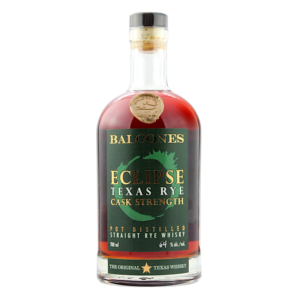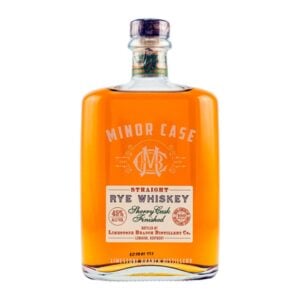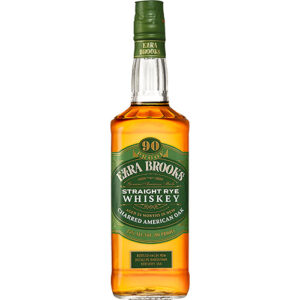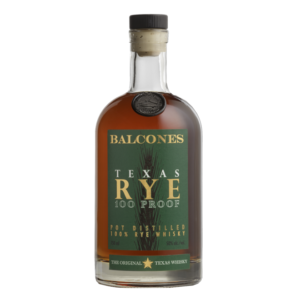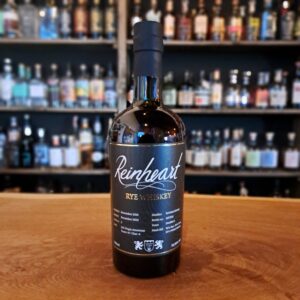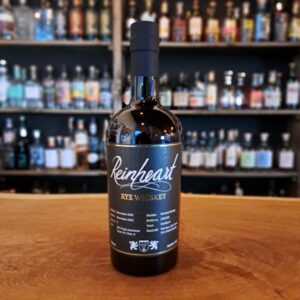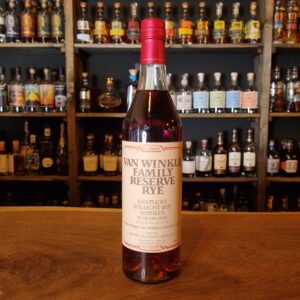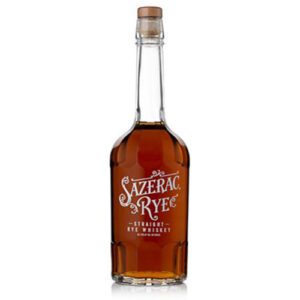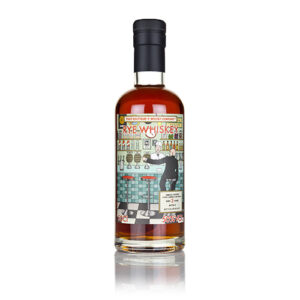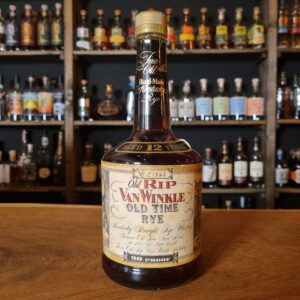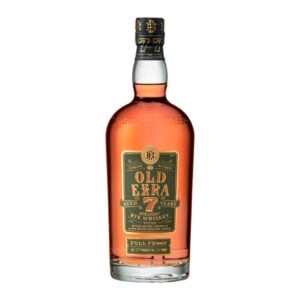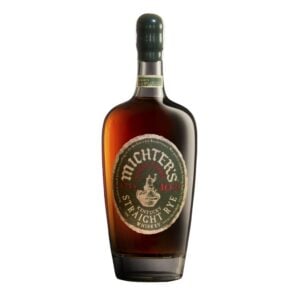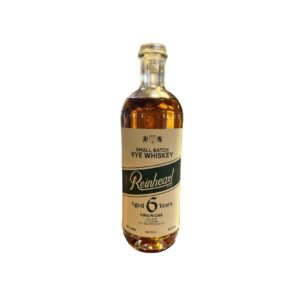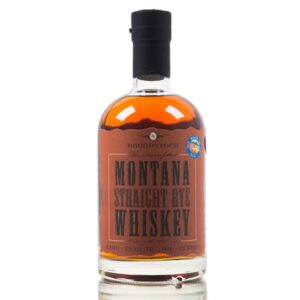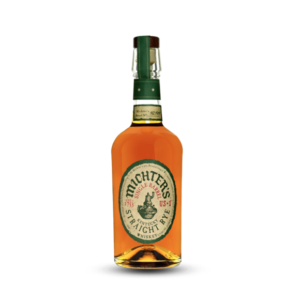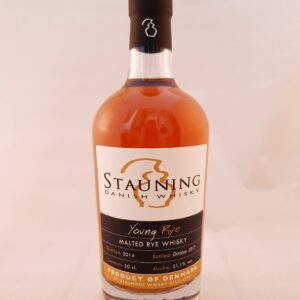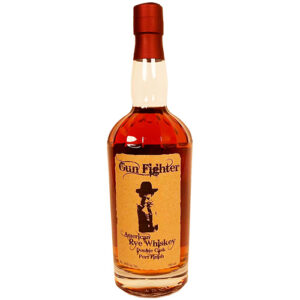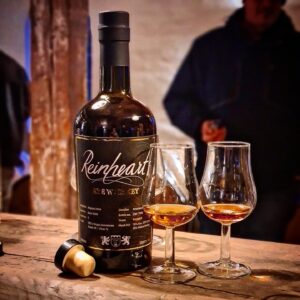Showing all 18 resultsSorted by popularity
Rye Whisky – The Complete Guide
TL;DR: In Brief
- Rye whisky is characterized by its spicy, bold flavor profile and minimum 51% rye grain content
- Primarily produced from rye, malted barley, and corn, defined by strict aging in new charred oak barrels
- Found in several styles, including American Rye, Canadian Rye, and Malted Rye
- Best enjoyed neat or with a drop of water, and shines in classics like the Manhattan or Sazerac
Disclaimer: This guide is intended for informational purposes for adults over 18 years old. Vault of Spirits encourages responsible alcohol consumption.
Introduction to Rye Whisky
Rye whisky has a rich history and fascinating craftsmanship behind it. From its origins in North America to its global popularity today, this spirit has evolved to become one of the world’s most appreciated whisky styles.
This guide provides insight into the production, flavor notes, and enjoyment of rye whisky, whether you’re a beginner or experienced enthusiast.
With its distinctive spicy character and versatility, rye whisky continues to experience a remarkable renaissance in the spirits world, captivating new generations of whisky lovers.
How Did Rye Whisky Originate?
From Past to Present
Rye whisky’s story begins in the early American colonies, particularly in Pennsylvania and Maryland, during the late 1700s.
European settlers, many of German and Dutch descent, brought their distilling traditions with them but faced a challenge: barley, the traditional whisky grain, didn’t grow as reliably as rye in the new climate.
Resourceful colonists adapted by using locally abundant rye grain, creating what would become America’s first indigenous whisky style.
By the late 18th century, rye whisky had become the dominant spirit of the northeastern United States, produced by both commercial distilleries and countless farmers who converted excess grain into a valuable, transportable commodity.
Which Historical Milestones Shaped Rye Whisky?
The Whiskey Rebellion of 1791-1794 represented a critical moment in rye whisky’s history.
When the federal government imposed an excise tax on distilled spirits, farmers in western Pennsylvania—primarily rye whisky producers—revolted, highlighting the economic importance of rye production.
Prohibition (1920-1933) nearly destroyed America’s rye whisky tradition, forcing many distilleries to close permanently.
After repeal, bourbon gradually replaced rye in popularity, relegating rye to near-obscurity until the craft cocktail renaissance of the early 2000s sparked renewed interest in this historic spirit.
How Has Rye Whisky Influenced Cultural Traditions?
In early America, rye whisky was more than a beverage—it was currency.
Farmers would convert their grain harvests into whisky, which was easier to transport and sell than raw grain, establishing rye as an integral part of the early American economy.
In literature and film, rye whisky often symbolizes American grit and resilience.
In Canada, rye whisky became so popular that “rye” became synonymous with “whisky,” regardless of actual rye content, demonstrating its cultural embedding in North American drinking traditions.
Why Is Rye Whisky Popular Today?
Rye whisky has experienced a remarkable resurgence, driven primarily by the craft cocktail movement.
Bartenders rediscovered that many pre-Prohibition cocktail recipes specifically called for rye whisky, whose spicy character stands up beautifully in mixed drinks.
Modern whisky enthusiasts increasingly seek bold, distinctive flavors rather than smoothness alone, making rye’s assertive profile particularly appealing.
The craft distilling boom has introduced countless new rye expressions, from traditional styles to innovative interpretations, further cementing rye’s place in contemporary drinking culture.
How Is Rye Whisky Made?
Which Raw Materials Are Used in Production?
The production of rye whisky centers around a specific set of grains and other raw materials that create its distinctive character.
Primary ingredients:
- Rye grain – The dominant ingredient, providing the whisky’s signature spicy character and must comprise at least 51% of the mash bill for American rye
- Malted barley – Supplies crucial enzymes that convert starches to sugars during mashing and contributes nutty, biscuity notes
- Corn – Often used as a secondary grain to add sweetness and balance rye’s natural spiciness
Water quality is equally important, with many distilleries prizing their water sources for specific mineral profiles that influence fermentation and final flavor.
How Does the Fermentation Process Work?
Fermentation transforms the rye mash into the alcoholic base for distillation.
After grinding the grains, distillers mix them with hot water in a mash tun, where the starches convert to fermentable sugars.
Specialized strains of Saccharomyces cerevisiae yeast are then added to the cooled mash, beginning the fermentation process.
Rye fermentations are notoriously challenging due to the grain’s high beta-glucan content, which creates a sticky, viscous mash.
This fermentation typically lasts 3-5 days, during which the yeast consumes sugars and produces alcohol, carbon dioxide, and hundreds of flavor compounds that contribute to the whisky’s final character.
Which Distillation Techniques Are Used?
Distillation concentrates and refines the alcoholic liquid, determining much of the whisky’s character.
Common distillation methods:
- Pot still distillation – Traditional method that retains more congeners and grain character, producing a more robust, full-bodied spirit
- Column still distillation – More efficient modern technique that allows greater control over the final spirit’s proof and character
- Double distillation – Common practice where the spirit passes through stills twice, refining the flavor while maintaining complexity
American rye whisky is typically distilled to no more than 160 proof (80% ABV), preserving essential flavor compounds that would be lost at higher distillation proofs.
What Is the Significance of Aging?
Aging is where rye whisky develops its mature character and color.
American rye must be aged in new, charred oak barrels, with no minimum time requirement for standard rye (though straight rye requires at least two years).
The charred interior of the barrel acts as a filter, removing harsh compounds while allowing the spirit to extract vanilla, caramel, and spice notes from the wood.
Rye whisky’s high ratio of congeners means it often benefits from extended aging, with many premium expressions matured for 4-8 years or longer.
Temperature fluctuations cause the whisky to expand and contract within the barrel, accelerating interaction with the wood and oxidation processes that develop complexity.
Which Regions Are Known for Rye Whisky?
Where Are the Best Variants Produced?
United States is the spiritual home of traditional rye whisky, with several distinct production regions.
Pennsylvania and Maryland were the historical epicenters of American rye production, each developing distinctive regional styles before Prohibition.
Kentucky, better known for bourbon, now produces many leading rye whiskies, leveraging bourbon-making expertise while highlighting rye’s distinctive character.
Canada has a long tradition of producing rye-influenced whiskies, though many “Canadian rye” whiskies actually contain relatively small amounts of rye grain.
Craft distilleries across the Northern United States, from New York to Washington State, are creating exciting new expressions that often highlight local terroir and grain varieties.
How Do Geography and Climate Affect the Flavor?
Climate plays a crucial role in rye whisky’s development during aging.
In Kentucky’s hot summers and cold winters, rye whisky experiences significant barrel interaction, developing rich caramel and vanilla notes alongside its spicy character.
Northern distilleries experience less extreme temperature swings, often resulting in a longer, more gradual maturation that preserves more of rye’s natural grain character.
Regional water sources impart unique mineral profiles that influence fermentation and ultimately the whisky’s flavor.
Local grain varieties, particularly heirloom rye strains, contribute terroir-specific flavors that can make regional styles truly distinctive.
What New Trends Are Seen in Rye Whisky Production?
Modern rye whisky production is a vibrant landscape of innovation and experimentation.
Many craft distillers are exploring 100% rye mash bills, creating intensely spicy, complex whiskies that highlight rye’s full potential.
Specialty malting, including malted rye, is gaining popularity for the enhanced flavors and simpler production process it offers.
Innovative cask finishing in port, rum, or wine barrels adds new dimensions to traditional rye profiles.
Estate-grown, heirloom rye varieties are being cultivated specifically for whisky production, emphasizing terroir and agricultural connections.
What Do the Different Quality Designations Mean?
Understanding rye whisky terminology helps navigate the category effectively.
“Straight Rye Whisky” must be aged at least two years in new charred oak and contain no additives.
“Bottled-in-Bond” rye must be the product of one distillation season, from one distillery, aged at least four years in a federally bonded warehouse, and bottled at exactly 100 proof.
“Rye Malt Whisky” must be made from at least 51% malted rye rather than raw rye grain.
Canadian “Rye Whisky” follows different rules than American versions and may contain very little actual rye grain, following historical naming conventions rather than strict ingredient requirements.
How Does Rye Whisky Taste?
What Characterizes the Typical Flavor Profile?
Rye whisky offers a distinctive flavor experience unlike any other whisky style.
Typical aromas:
- Spice notes – Black pepper, cinnamon, clove, and nutmeg create rye’s signature warmth
- Fruit elements – Green apple, cherry, and dried fruit add complexity and balance
- Herbal qualities – Mint, dill, caraway, and anise often appear, especially in high-rye mashbills
On the palate, rye typically presents a drier character than bourbon, with less sweetness and more grain-forward flavors.
The mouthfeel tends to be substantial and sometimes slightly oily, with a warming sensation that develops as you sip.
The finish is often long and warming, with lingering spice notes and a pleasant dryness that makes it particularly suitable for cocktails.
How Does the Flavor Vary Between Different Styles?
American rye whisky (51%+ rye) delivers bold spice notes, often accompanied by vanilla and caramel from new charred oak aging.
Traditional Pennsylvania-style rye (historically 65-80% rye) presents more intense grain character with pronounced spice and less sweetness.
Maryland-style rye (historically lower rye percentage) tends to be slightly sweeter and fruitier, with more accessibility for beginners.
Canadian rye whiskies often show lighter, smoother profiles with subtle spice notes, as they frequently contain a smaller percentage of rye grain.
Malted rye whisky offers a unique profile with enhanced bread-like, cocoa, and nutty notes alongside the typical spice character.
How Does the Flavor Develop with Age?
Young rye whisky (2-4 years) typically showcases vibrant grain character with sharp spice notes and noticeable alcohol presence.
Mid-aged expressions (4-8 years) develop more balance as barrel influence increases, introducing caramel, vanilla, and oak while taming some of rye’s initial sharpness.
Well-aged rye (8+ years) often presents remarkable complexity, with deeper dried fruit notes, rich baking spices, and elegant oak integration.
Extended aging can introduce interesting tertiary notes like leather, tobacco, and dark chocolate, particularly in whiskies aged in climates with significant temperature variations.
What Signs Reveal High Quality?
Superior rye whisky demonstrates balance between grain character and barrel influence, rather than having one dominate the other.
Complex layering of flavors that evolve throughout the tasting experience indicates careful production and proper maturation.
A long, evolving finish that continues to reveal new flavor notes long after swallowing is a hallmark of exceptional rye.
Mouthfeel should be substantial without being harsh or thin, with a pleasant warming quality rather than a burning sensation.
High-quality rye maintains its distinctive spicy character while integrating complementary flavor elements in a harmonious whole.
How Is Rye Whisky Best Enjoyed?
What Is the Optimal Serving Method?
For maximum appreciation of rye’s complex character, try it neat in a proper tasting glass.
Adding a few drops of spring water can open up aromas and flavors, particularly with higher-proof expressions.
A single large ice cube can be enjoyable for casual sipping, gently cooling and diluting the whisky as you drink.
Rye’s bold profile makes it exceptionally versatile in cocktails, standing up to mixing while maintaining its distinctive character.
Temperature matters—slightly below room temperature (around 60-65°F/15-18°C) often presents the best balance of aroma and flavor.
Which Glass and Temperature Is Ideal?
A tulip-shaped glass like a Glencairn concentrates aromas at the narrow opening, enhancing the nosing experience.
Traditional rocks glasses are perfect for rye served with ice or in simple mixed drinks.
Nick & Nora or coupe glasses showcase rye cocktails elegantly while maintaining proper temperature.
Avoid chilling the glass itself, as excessive cold suppresses rye’s expressive aromas.
Allow refrigerated bottles to warm slightly before serving to experience the full range of flavors.
How Do You Taste Like an Expert?
Begin with visual assessment, noting color depth and viscosity when swirled, which can indicate age and body.
Nose gently at first, then more deeply, identifying specific aroma families—spice, fruit, grain, wood, and earthy notes.
Take a small sip and allow it to coat your entire mouth before swallowing, noting how flavors evolve from entry to finish.
Consider structural elements like body, heat, sweetness, dryness, and texture, not just flavor notes.
Add a few drops of water and repeat the process, noting how dilution changes the experience—this can reveal hidden complexities.
Which Dishes Complement Rye Whisky?
Strong, aged cheeses like sharp cheddar or gouda stand up beautifully to rye’s bold profile.
Smoked meats, particularly beef brisket or pastrami, echo rye’s spicy character while adding complementary savory notes.
Dark chocolate with at least 70% cacao content pairs wonderfully with rye, the bitterness balancing the whisky’s spice.
Apple-based desserts highlight the fruit notes often present in rye’s flavor profile.
Spiced nuts provide textural contrast while complementing rye’s natural spiciness—try pecans with cayenne and brown sugar.
Which Cocktails Can Be Made with Rye Whisky?
Which Classic Cocktails Should You Know?
Manhattan
- Ingredients: 2 oz rye whisky, 1 oz sweet vermouth, 2-3 dashes Angostura bitters, cherry garnish
- Preparation: Stir with ice, strain into a chilled coupe or cocktail glass
- History: Created in the 1870s at the Manhattan Club in New York, originally made with rye before bourbon became a common substitute
Sazerac
- Ingredients: 2 oz rye whisky, 1 sugar cube, 3 dashes Peychaud’s bitters, absinthe rinse, lemon peel
- Preparation: Rinse a chilled old-fashioned glass with absinthe; separately, muddle sugar with bitters, add rye and ice, stir, strain into the prepared glass
- History: America’s oldest known cocktail, originating in New Orleans in the 1850s, initially made with cognac before rye became the standard
Old Fashioned
- Ingredients: 2 oz rye whisky, 1 sugar cube, 2-3 dashes Angostura bitters, orange peel
- Preparation: Muddle sugar with bitters, add rye and ice, stir, garnish with expressed orange peel
- History: One of the first drinks to be called a “cocktail,” with rye being the original whisky of choice in the early 19th century
Which Modern Cocktails Are Worth Trying?
Boulevardier variation with rye instead of bourbon creates a spicier, more complex drink that beautifully balances the Campari’s bitterness.
Vieux Carré, with rye, cognac, sweet vermouth, Benedictine, and bitters, showcases rye in a sophisticated, multi-layered experience.
Toronto, mixing rye with Fernet-Branca, simple syrup, and bitters, creates an intriguing herbal-spice combination.
Brooklyn cocktail pairs rye with dry vermouth, maraschino liqueur, and Amer Picon for a complex, less sweet alternative to the Manhattan.
Newer creations like the Paper Plane (bourbon, Aperol, Amaro Nonino, lemon juice) can be reimagined with rye for added depth and spice.
How Is Rye Whisky Enjoyed Neat?
Serving neat in a proper tasting glass allows full appreciation of rye’s complex aroma and flavor profile.
Adding a few drops of spring water can “open up” high-proof rye, releasing volatile compounds and softening alcohol heat.
On the rocks with a single large ice cube provides gradual dilution and cooling that can make rye more approachable while maintaining character.
Rye and ginger ale makes a simple, refreshing highball that highlights rye’s spiciness against the sweet, effervescent mixer.
A classic rye and soda with a lemon twist offers a low-sugar option that showcases the whisky’s character.
Which Homemade Variants Can You Experiment With?
Infuse rye with cinnamon sticks and dried cherries for a home-blended whisky perfect for winter cocktails.
Create a custom vermouth blend specifically designed to complement your favorite rye in Manhattans.
Experiment with homemade bitters using ingredients that enhance rye’s natural spice notes, like cardamom, star anise, or orange peel.
Age rye in a mini oak barrel with toasted wood chips for a custom-finished expression.
Blend different rye whiskies to create your own perfect house style, balancing spice, sweetness, and barrel character.
What Should You Know Before Buying Rye Whisky?
Which Details Should You Pay Attention to When Purchasing?
Check the label for “Straight Rye Whisky,” which guarantees no additives and at least two years of aging.
Look for specific rye content if disclosed—higher percentages (90-100%) typically deliver more pronounced spice character.
Age statements provide valuable information, though older isn’t always better—many excellent ryes are aged 4-6 years.
Bottled-in-Bond designation guarantees certain quality standards, including 100 proof and minimum four years aging.
For craft offerings, research the distillery’s approach—some produce their whisky from grain to bottle, while others source and bottle existing whisky.
What Do You Get for Your Money in Different Price Ranges?
Entry-level ($20-35): Solid mixing ryes with straightforward flavor profiles, perfect for cocktails and casual sipping.
Mid-range ($35-60): Higher quality daily drinkers with more complexity and character, suitable for both mixing and neat consumption.
Premium ($60-100): Well-aged or special production methods offering sophisticated flavor profiles and excellent neat-sipping experiences.
Super-premium ($100+): Limited editions, rare expressions, and extended age statements with exceptional complexity and unique characteristics.
Vintage/collectible (varies): Historical bottlings or extremely rare releases that may offer exceptional drinking experiences but are often purchased more for collection than consumption.
How Is Rye Whisky Properly Stored?
Store bottles upright to prevent the high-proof alcohol from degrading the cork over time.
Keep away from direct sunlight, which can fade labels and potentially affect flavor through heat fluctuations.
Maintain a consistent, cool temperature—significant temperature fluctuations can accelerate unwanted chemical changes.
Once opened, consider transferring whisky from near-empty bottles to smaller containers to minimize oxidation.
Unlike wine, properly sealed whisky doesn’t continue to age or improve in the bottle, so there’s no advantage to long-term storage of opened bottles.
Is Rye Whisky a Good Investment?
Limited edition releases from established distilleries often appreciate in value, particularly those from beloved brands with collector followings.
Vintage ryes from defunct distilleries can command extraordinary prices as they represent unreproducible pieces of whisky history.
The market for collectible rye has grown substantially in recent years, though it remains smaller than the bourbon investment market.
Bottles intended for investment should be stored properly, with intact tax strips and in original packaging when possible.
Remember that spirits investments are unregulated and illiquid—only invest in bottles you’d be happy to drink if they don’t appreciate in value.
Which Brands Do We Recommend?
What’s Best for Beginners?
Rittenhouse Bottled-in-Bond offers exceptional value with a classic, versatile profile perfect for cocktails and approachable neat sipping.
Old Forester Rye delivers a smooth, balanced introduction to the category at a reasonable price point.
Sazerac Rye (Buffalo Trace) presents a gentler, sweeter style that eases newcomers into rye’s spicier characteristics.
High West Double Rye blends young and old ryes for an approachable yet complex profile with excellent versatility.
Woodford Reserve Rye offers a polished, refined entry point from a familiar bourbon producer.
What Will Impress Enthusiasts?
WhistlePig 10 Year provides a full-bodied, richly spiced experience that showcases extended aging of high-rye content whisky.
Pikesville 6 Year 110 Proof revives a historic Maryland style with exceptional depth and complexity.
Willett Family Estate Rye offers single barrel expressions with remarkable character variation and intensity.
Michter’s 10 Year Single Barrel Rye presents exceptional balance of spice and oak with a luxurious mouthfeel.
New Riff Single Barrel Rye brings craft credentials with no-shortcuts production methods and bottled-in-bond quality.
Which Bottles Are Most Sought After?
Van Winkle Family Reserve Rye 13 Year shares the legendary status of its bourbon siblings, with exceptional depth and integration.
Thomas H. Handy Sazerac Rye from the Buffalo Trace Antique Collection offers uncut, unfiltered power with remarkable complexity.
Vintage Rittenhouse 21, 23, or 25 year expressions are highly coveted for their extraordinary depth and historical significance.
Kentucky Owl Rye batches have achieved cult status for their exceptional blending and full-flavored profiles.
Limited editions from Japanese producers like Chichibu or Nikka experimenting with rye showcase fascinating international interpretations.
Where Do You Get the Most for Your Money?
Rittenhouse Bottled-in-Bond remains the industry standard for value, delivering remarkable quality at around $25.
Wild Turkey 101 Rye offers bold flavor, respectable age, and higher proof at an extremely competitive price point.
Old Forester Rye provides exceptional cocktail versatility and neat-sipping quality at under $30.
Russell’s Reserve 6 Year Rye delivers well-aged character and complexity at a mid-range price.
Knob Creek Rye offers substantial proof, age, and flavor intensity at a remarkably fair price relative to its quality.
Frequently Asked Questions
What Is Rye Whisky?
Rye whisky is a spirit distilled from a grain mash containing at least 51% rye (in American versions), aged in charred new oak barrels.
It’s characterized by its spicy, bold flavor profile with notes of pepper, cinnamon, and dried fruit.
In the United States, rye whisky must be distilled to no more than 160 proof, entered into barrels at no more than 125 proof, and bottled at a minimum of 80 proof.
Canadian “rye whisky” follows different regulations and may contain very little actual rye grain, instead being a style designation based on historical naming practices.
How Is Rye Whisky Produced?
Production begins with creating a mash of at least 51% rye grain, combined with other grains like malted barley and corn.
This mash is fermented with yeast to create a beer-like liquid of about 8-10% alcohol.
The fermented mash is then distilled, typically twice, concentrating the alcohol and flavor compounds.
The clear distillate is aged in new, charred oak barrels for at least two years for “straight rye whisky,” developing color and additional flavors.
Finally, the matured whisky is often filtered and diluted to bottling strength before packaging.
What Characterizes Rye Whisky?
The most distinctive characteristic is a pronounced spicy character with notes of black pepper, cinnamon, and clove derived from the rye grain.
Rye typically presents a drier profile than bourbon, with less pronounced sweetness and more grain-forward flavors.
Many ryes feature herbal and floral notes alongside the spice, creating a complex, layered flavor experience.
The legal requirement of new charred oak aging contributes vanilla, caramel, and oak notes that complement the spicy rye character.
Rye’s bold profile makes it particularly suited for cocktails, where it maintains its character even when mixed with other ingredients.
Where Can You Buy Rye Whisky?
Well-stocked liquor stores typically carry at least a few rye whisky options, with specialty stores offering broader selections.
Online retailers like Whisky Exchange, Master of Malt, or Caskers provide extensive rye whisky selections with detailed product information.
Distillery direct purchases are increasingly available, with many producers offering online sales where legally permitted.
Specialty whisky shops in major cities often carry rare, limited edition, or vintage ryes not found in regular retail channels.
Auction sites like Whisky Auctioneer or Sotheby’s Wine occasionally offer collectible or discontinued rye whiskies for serious collectors.
